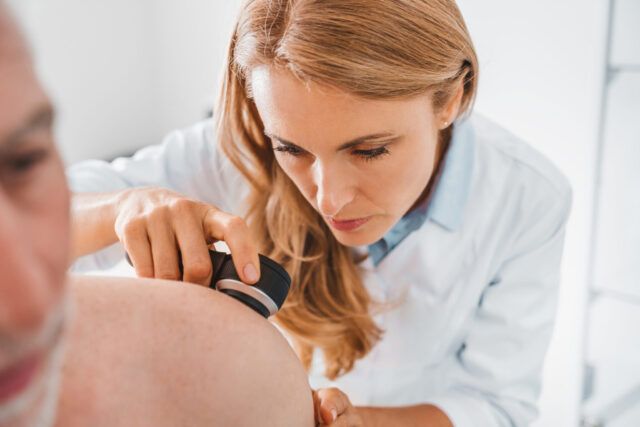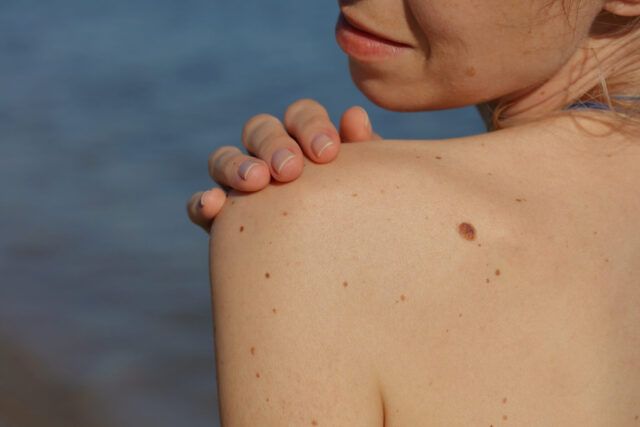May is Skin Cancer Awareness Month
Skin cancer is the most common cancer in Ireland, with over 13,000 new cases diagnosed every year.
The National Cancer Registry of Ireland (NCRI) expects this number to double by 2040.
With this concerning forecast in mind, knowing what steps can be taken, the skin changes to look out for, and how to perform a self-exam is key to preventing the development of skin cancer.
Why is SPF so important?
By now, we (hopefully) all understand the importance of wearing SPF on our skin.
Not just when the sun is shining, but every single day.
SPF protects our skin against UV radiation—UVA and UVB.
UVA radiation makes up 95 per cent of all the UV rays that make it to the Earth’s surface and it contributes to the skin’s ageing.
UVB is a high-energy radiation that makes up the remaining five per cent and is associated with sunburn, which damages skin cells and causes DNA mutations that can eventually lead to melanoma and other types of skin cancer.
Wearing a good SPF is paramount to protecting against both forms of UV radiation.
Without it, your skin is left exposed, both from a purely aesthetic point of view and, more importantly, from a health perspective.

Skin changes to look out for
According to the Cancer Council, survival from melanoma is strongly linked with the depth of invasion, e.g. the deeper and thicker a melanoma is, the more likely to metastasise and be more difficult to treat.
Therefore, early detection is extremely important.
In many cases, melanomas are found by patients or their partners, and knowing what to look out for may help with early detection.
According to the Irish Cancer Society, skin cancers do not all look the same.
They can appear in several ways, including any of the following:
- A small lump
- Flat, red spot
- Firm, red lump
- A lump or spot that is tender to touch
- An ulcer that will not heal
- A lump with a scaly or horny top
- Rough, scaly patches
- A new or changing mole
Meanwhile, non-melanoma often appears as one of the following:
- A new growth or sore that does not heal in a few weeks.
- A spot or sore that continues to itch, hurt, crust, scab, or bleed.
- A skin ulcer that is not explained by other causes.
Mole changes to look out for
Melanoma mainly develops either from a new mole or a change to an existing one.
Moles can be present from birth or can appear later during childhood or adolescence and most moles are harmless.
Once a mole appears, it will usually stay the same shape, size, and colour for many years, often fading when a person reaches old age.
The cancer research organisation adds that a normal mole will be evenly coloured brown, tan, or black spot.
It can be flat, raised, round, or oval, but usually will be smaller than the size of the top of a pencil.
According to the Irish Cancer Society, the changes to watch out for in existing moles are:
- Change in shape: From a round and regular shape to ragged edges or an irregular shape with one half unlike the other.
- Change in size: From the size of the top of a pencil and getting bigger.
- Change in colour: From one colour to many shades of tan, brown or other colours. Some melanomas can also lose colour
- The mole looks red or inflamed around the edges
- The mole is bleeding, oozing or crusting
- The mole starts to feel different, for example, slightly itchy or painful.
It’s important to note that not all melanomas develop from moles so it is vital to speak to your doctor if you spot other skin changes that are unusual for you.

How to perform a skin self-exam
The first important tip to remember with skin self-exams is to do them regularly.
Examine yourself from head to toe every month and learn where your moles, freckles and other skin marks are.
Stand in front of a long mirror and have a hand mirror that you can use to check parts that are hard to see.
- Check your face, especially your nose, lips, mouth, and the front and back of your ears.
- Check your front, groin, and your back. Lift your breasts to check the skin under them.
- Check your sides with your right and left arms raised.
- Bend your elbows and look carefully at your forearms and upper underarms.
- Look at your fingernails, between your fingers, the back of your hands, and the palms of your hands.
- Examine the back of your neck and scalp with a hand mirror. Part your hair in sections with a comb or use a hairdryer so you can see your scalp clearly.
- Check your back and shoulders, the backs of your arms and upper legs, and your buttocks with a mirror.
- Check your legs and feet all over, including the soles, and toes, between your toes and your toenails. Put your foot on a stool or chair so you can see between your legs with a hand mirror.
Prevention
According to the Mayo Clinic, several measures can be taken to help prevent the development of melanoma or skin cancer.
Such measures include:
- Avoid tanning lamps and beds. Tanning lamps and beds give off ultraviolet light, also called UV light (Nine out of every 10 cases are caused by UV rays from the sun or sunbeds).
- Avoid the sun during the middle of the day (the sun’s rays are strongest between about 10 am and 4 pm).
- Become familiar with your skin so that you’ll notice changes (e.g. self-exams).
- Wear protective clothing.
- Wear sunscreen year-round (at least SPF 30).
READ MORE:
- Irish beauty brand Sculpted by Aimee was behind this stunning look at the Met Gala
- ‘Just two hours of scrolling each day equals 30 days of the year wasted’
- The ultimate wedding skincare guide: Expert tips from Dr. Nina Bal
- ‘My foundation contains SPF15 but my moisturiser is SPF50 – which protection do I have?’
















































